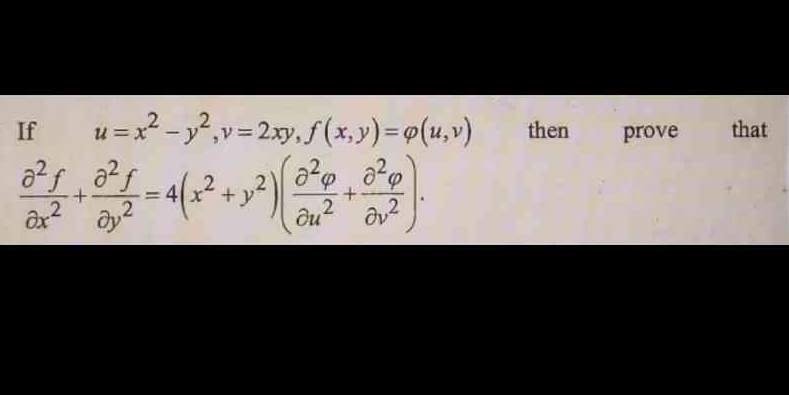If u = x^2 - y^2, v = 2xy, f(x,y) = φ(u,v) then prove that ∂²f/∂x² + ∂²f/∂y² = 4(x² + y²)(∂²φ/∂u² + ∂²φ/∂v²).

Understand the Problem
The question is asking for a proof involving partial derivatives of a function defined in terms of new variables u and v, where u and v are functions of x and y. It requires using the chain rule and the relationship between the derivatives of the function f and the function φ.
Answer
$$ \frac{\partial^2 f}{\partial x^2} + \frac{\partial^2 f}{\partial y^2} = 4(x^2 + y^2) \left( \frac{\partial^2 \phi}{\partial u^2} + \frac{\partial^2 \phi}{\partial v^2} \right) $$
Answer for screen readers
$$ \frac{\partial^2 f}{\partial x^2} + \frac{\partial^2 f}{\partial y^2} = 4(x^2 + y^2) \left( \frac{\partial^2 \phi}{\partial u^2} + \frac{\partial^2 \phi}{\partial v^2} \right) $$
Steps to Solve
- Calculate the first derivatives of f
Using the chain rule for the function ( f(x, y) = \phi(u, v) ):
[ \frac{\partial f}{\partial x} = \frac{\partial \phi}{\partial u} \frac{\partial u}{\partial x} + \frac{\partial \phi}{\partial v} \frac{\partial v}{\partial x} ]
Calculating ( \frac{\partial u}{\partial x} ) and ( \frac{\partial v}{\partial x} ):
[ \frac{\partial u}{\partial x} = 2x, \quad \frac{\partial v}{\partial x} = 2y ]
So,
[ \frac{\partial f}{\partial x} = \frac{\partial \phi}{\partial u} \cdot 2x + \frac{\partial \phi}{\partial v} \cdot 2y ]
- Calculate the second derivative with respect to x
Now, differentiate ( \frac{\partial f}{\partial x} ) with respect to ( x ):
[ \frac{\partial^2 f}{\partial x^2} = \frac{\partial}{\partial x} \left( \frac{\partial \phi}{\partial u} \cdot 2x + \frac{\partial \phi}{\partial v} \cdot 2y \right) ]
Using the product rule, we have:
[ \frac{\partial^2 f}{\partial x^2} = \frac{\partial^2 \phi}{\partial u^2} \cdot (2x)(2x) + \frac{\partial \phi}{\partial u} \cdot 2 + \frac{\partial^2 \phi}{\partial v \partial u}(2y)(2x) + \frac{\partial^2 \phi}{\partial v^2} \cdot 0 ]
- Calculate the first derivatives of f with respect to y
Now calculate ( \frac{\partial f}{\partial y} ):
[ \frac{\partial f}{\partial y} = \frac{\partial \phi}{\partial u} \cdot 2(-y) + \frac{\partial \phi}{\partial v} \cdot 2x ]
- Calculate the second derivative with respect to y
Differentiate again:
[ \frac{\partial^2 f}{\partial y^2} = \frac{\partial}{\partial y} \left( -2y \frac{\partial \phi}{\partial u} + 2x \frac{\partial \phi}{\partial v} \right) ]
Using the product rule similarly:
[ \frac{\partial^2 f}{\partial y^2} = -2y \cdot \frac{\partial^2 \phi}{\partial u^2} \cdot 2(-y) + \frac{\partial \phi}{\partial u} \cdot 0 + 2x \cdot \frac{\partial^2 \phi}{\partial v^2} ]
- Combine the second derivatives
Now combine the second derivatives to equate:
[ \frac{\partial^2 f}{\partial x^2} + \frac{\partial^2 f}{\partial y^2} = 4(x^2 + y^2) \left( \frac{\partial^2 \phi}{\partial u^2} + \frac{\partial^2 \phi}{\partial v^2} \right) ]
$$ \frac{\partial^2 f}{\partial x^2} + \frac{\partial^2 f}{\partial y^2} = 4(x^2 + y^2) \left( \frac{\partial^2 \phi}{\partial u^2} + \frac{\partial^2 \phi}{\partial v^2} \right) $$
More Information
This proof demonstrates how the second derivatives of a function can be related through the chain rule when changing variables from ( (x, y) ) to ( (u, v) ). The resulting relationship is significant in multivariable calculus and can be applied in various fields such as physics and engineering.
Tips
- Failing to apply the product rule appropriately when taking derivatives.
- Miscalculating the mixed partial derivatives, especially when variables ( u ) and ( v ) are involved.
- Forgetting to include all terms when combining the second derivatives.
AI-generated content may contain errors. Please verify critical information